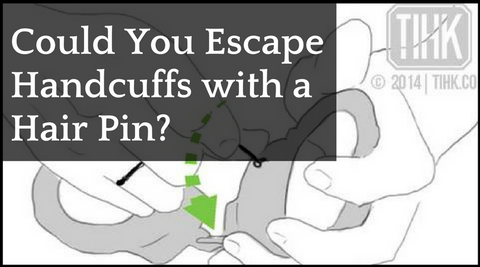For any seemingly impenetrable object out there, there's someone who has looked at it and thought to themselves... "I should shoot that." Handcuffs are no exception. Supposedly this video is a myth-busting endeavor meant to prove whether or not handcuffs can be shot open like they occasionally do in the movies, but we're pretty sure the underlying motivation is... well, it's fun to shoot stuff.
Shop Urban Survival Gear
In this video we found thanks to Guns.com, Edwin Sarkissian uses a Glock to try and shoot open a pair of S&W cuffs. As to whether or not he is successful, well... you'll just have to watch the video.
The short answer is, of course, yes- if you shoot a gun at a pair of handcuffs there's a good chance that (at least on the third or fourth try) they'll come apart. As to whether that's a viable option in an emergency... you're probably better off investing in a universal handcuff key that you can keep on your person. Less risk of shooting your hand off.
Get your tiny inconspicuous handcuff key now!
Over on SOFREP there's a new article up on how to pick handcuffs with nothing but a hairpin. It's a really helpful tutorial with step-by-step photos showing how a simple bobby pin can be used in a pinch to unlock a pair of handcuffs. He also explains the easier method of shimming, which is a really useful skill to have as well. The caveat is that a shim cannot be used on double-locked handcuffs. Double-locked cuffs are very common now, so you want to be sure that you have practiced a few methods of escaping them as well.
This is incredibly useful information to know, and important to practice if you are in law enforcement, security, or you travel regularly, especially to unstable countries or places where you don't speak the language. We created a similar tutorial with illustrations- check it out here.
There is no telling when handcuffs could be unlawfully used against you. Whether they're your own cuffs being used against you by a criminal, or an unlawful incident with corrupt police in a foreign country, it pays to have the knowledge and skill that will enable you to escape from unlawful restraint.
Being truly prepared for anything means having a Plan A, a Plan B, and preferably a Plan C as well. Flexibility and quick thinking under stressful circumstances will help you escape hairy situations with your life, and maybe even dignity, intact. So what do you do if your trusty hair pin slips out of your pocket? It would pay to have a tiny, inconspicuous handcuff key on your person as well. Not only are they easier to master than a bobby pin or shim, but if you know what you are doing they will buy you precious seconds as well. Check them out here and get prepared!
Shop Urban Survival Gear
A complaint we receive a lot is that we must be marketing a product directly to criminals. After all, police are the ones who use handcuffs. Bad guys are desperate, and they work on the fly and use duct tape, zip ties, rope, or cable when they want to restrain someone. We’ll get to that argument in a minute. First, let’s talk about the debate over mere possession of a cuff key.
The intended purpose of an item that can be used to cause harm has been strong on the public’s mind since the tragic shooting in Las Vegas. Many gun-control advocates insist that you can defend yourself in other ways if you are being attacked, and you don’t need a gun. The purpose of a gun is to cause serious bodily harm. The argument is that no one really needs access to such a thing.

This article is not about gun control, but we encounter a similar argument against the possession of handcuff keys by law-abiding citizens. Those who don’t understand why anyone who isn’t a criminal would want to possess a handcuff key argue that it’s pointless, because bad guys don’t use handcuffs. Therefore anyone who wants to own a cuff key must be either a criminal or paranoid.
Interestingly, many of the people making this argument will fight tooth and nail for our second-amendment right to bear arms. The gist of the matter to them is that possessing a firearm is your right as an American citizen, and you do not have to explain your motives. Those motives, of course, are usually sound and legal. Hunting, home defense, sheer enthusiasm. Why not extend the same courtesy to those who want to own a cuff key, an item which is arguably less dangerous than a firearm? Unless you try to swallow the thing and choke to death, a handcuff key can’t hurt you. Even in the hands of the baddest bad guy. It can, however, save your life.
What’s that, you say? Bad guys don’t use handcuffs? We’ll just leave these here…
- In the summer of 2015, a postal employee with a restraining order placed against him by family members was arrested and discovered to be in possession of multiple weapons and handcuffs on federal property.
- In the fall of 2012, an offender with no prior record perpetrated multiple kidnappings and sexual assaults using, among other tools, a sedating drug, zip ties, and handcuffs.
- Earlier this year, three victims were kidnapped and detained in handcuffs in the basement of a man who appeared to be having a “schizophrenic episode”.
- This past spring an older man was handcuffed and physically assaulted in his own home after a group of burglars broke in.
- In 2015 an elderly couple was handcuffed as their home was burglarized of over $10,000 worth of cash and jewelry.
It is insanely easy to buy handcuffs. There are no restrictions on the sale of the very same handcuffs used by our law enforcement officers. You can have a pair shipped to you in just a few clicks. And sure… most of the people buying them are probably law enforcement, security, and perhaps a small subset of lock picking enthusiasts. But there’s another group of people buying handcuffs, and the stories above prove that it’s not just an isolated incident every few years. Bad guys use handcuffs. It’s not just reasonable to carry a handcuff key just in case… it’s the smart choice.
The modern standard of handcuffs is the design popularized by Peerless in the early 1900’s, with few alterations since then. Most handcuff brands now bear a similar design, with only minor variances amongst the locks themselves. The design is known as a swing cuff, which features a freely swinging ratchet arm that allows law enforcement to secure the cuffs with just one hand, improving speed, agility, and safety. The most significant differences between handcuffs are found in the way the cuffs connect.
Chain Handcuffs
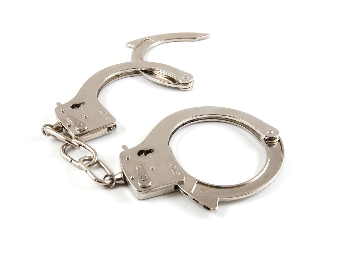
Chain handcuffs are the most widely used among law enforcement for everyday arrests due to their ease of application. The two cuffs are attached by a short chain, just one or two links long. This chain allows the cuffs to be folded in half for improved portability. The ratchet arms on chain cuffs are usually swing-through for ease and speed of application: they can be applied to the subject’s wrist with just one hand.
Hinged Handcuffs
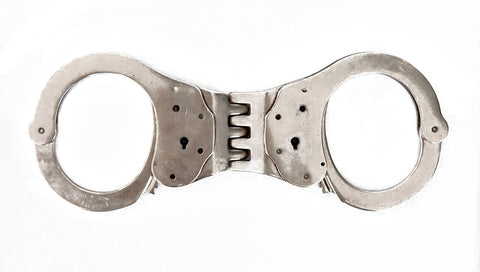
Hinged cuffs are very similar to chain cuffs, but they are connected with a large hinge rather than chain links. Hinged cuffs are shorter than chain cuffs when extended, which allows for less hand/arm mobility. This makes hinged cuffs potentially more secure, but somewhat more difficult to apply to a testy subject. Many law enforcement officers find that the solution to this problem, if one wrist has been cuffed but the subject is non-compliant, is the ability to apply uncomfortable torque on the cuffed wrist as a method of persuasion. The hinge adds some overall strength to the cuffs as well. Though it’s very rare, the occasional Hercules (probably somebody on drugs) may be able to snap the chain links between traditional handcuffs, but with hinged cuffs on he’s going nowhere. Like chain cuffs, hinged cuffs can be folded in half.
Solid Bar Handcuffs
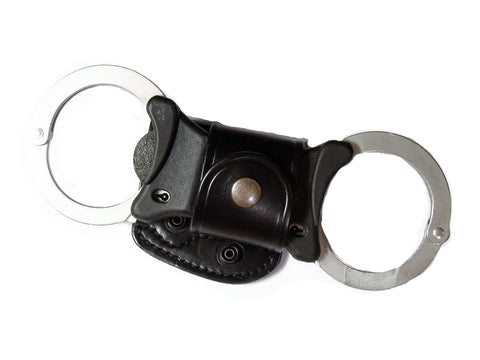
Solid bar handcuffs provide the same level of tamper-resistance as hinged handcuffs and even less mobility, but they come with the caveat of being harder to carry because they cannot be folded in half. Their appeal lies in the ability for an officer to apply pain-compliance techniques. Handcuffs connected with a solid bar are most likely to be used for prisoner transport of individuals who are known to be non-compliant.
Waist Chains
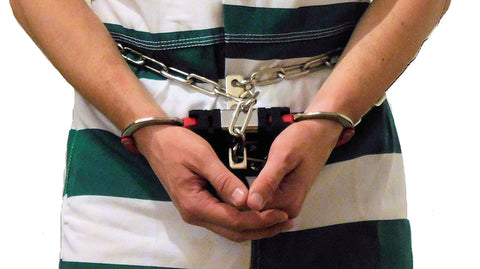
Though not technically a type of handcuffs by themselves, waist chains are worth noting here for the added security they bring. The purpose of a waist chain is to further reduce a subject’s mobility. They are unable to bring their hands higher or lower than their belly, thus preventing violence and tampering.
High Security Handcuffs
High security handcuffs can take the form of any of the three basic types of handcuffs listed above. The primary difference is that high security handcuffs cannot be opened with a standard barrel-shaped universal handcuff key. High security handcuffs are keyed individually and are more pick-resistant than their lower security counterparts. Some high security cuffs include an additional locking position to increase the security of the double lock.




